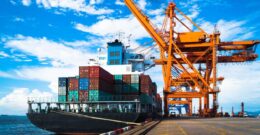Supply chain stress is at its highest level in recent history far higher, for instance, than during the global financial crisis of 2008, according to KPMG’s new “Supply Chain Stability Index.” At the same time, an S&P Global survey of supply chain professionals concluded that 2022 was “a tumultuous year in review, with no end in sight.”
Internet of Things (IoT)
The rapid rollout of new higher speed, lower latency wireless technologies from ubiquitous 5G cellular to in-building Wi-Fi 6 and 7 is driving billions of new IoT connections, and the supply chain is a primary benefactor. Working with other wide area wireless networks and in-building networks, 5G will continue to expand cloud-based networks’ capabilities with sensors and edge computing to gather and process data on operations and logistics closer to the source. Gartner predicts that 25% of supply chain decisions will be made across intelligent edge ecosystems by 2025.
Cloud-Based Solutions
The cloud is now the standard platform for most supply chain software, according to an annual survey by MHI, a supply chain industry trade association that projects a 40% adoption rate of cloud computing and storage in 2022 to reach 86% in 2027.
Pervasive cloud computing is laying the foundation for several supply chain innovations. For example, so-called mesh technology enables the capture and combination of data from multiple supply chain systems to create a “digital twin,” a virtual replica that can be used to facilitate decision-making and intelligent orchestration of operations. In practical terms, for example, inventory data can be combined with transport schedules and allocated transport vehicles to avoid stock outs.
Advanced Automation
In 2022, the recognition has sunk in: The labour shortage is not going away. No wonder nearly 80% of supply chain leaders have accelerated their digital transformation, with the adoption of supply chain robotics and automation expected to nearly triple in the next five years, according to the MHI survey.
Surveys show that supply chain leaders are looking to automate using everything from robots in the warehouse to artificial intelligence (AI) in the back office. The goal is to elevate operations from the automated to the autonomous supply chain, defined by Capgemini as “an integrated, frictionless and customer-centric supply chain function that delivers cognitive, touch less operations and transparent data-driven decision-making.”
AI and Machine Learning
If agility is the motivational force behind supply chain trends in 2023, AI and machine learning are the accelerators. AI is expected to see the fastest growth in the next five years among all advanced technologies ranked in the MHI annual survey — in use by only 15% of respondents today but rising to 73% over the next five years.
Yet even companies that have already invested in AI have so far failed to realize its full potential, experts say. They’ve largely employed its predictive capabilities to forecast demand for planning purposes, a BCG report found, but coming years will give AI a larger role in supply chain operations, as supply teams come to trust its autonomous decision-making capabilities.

